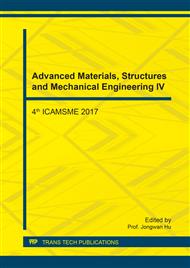[1]
Y. X. Zhou, X. X. Jiang, W. J. Chen, et al. Arc discharge and gas-generating characteristics in transformer oil under AC / DC composite voltage. High Volt. Tech. 37(7) (2011) 1584-1589.
Google Scholar
[2]
D. Lu, J. LI, J. Yang. Study and Development of Quantitative Evaluation System for Steam Cloud Explosion. Fire Sci. Tech. 28(12) (2011) 82-84.
Google Scholar
[3]
R. H. Zhang, G. H. Chen, H. Zhang, J. TNO multi-energy method in the application of steam cloud explosion simulation evaluation. South China Univ. Technology (Nat. Sci. Ed. ), 34(5) (2006) 109-114.
Google Scholar
[4]
S. J. Wang, D. Lu, X. Zhang. Study on Assessment of Steam Cloud Explosion Damage Range Based on TNO Multi-energy method. J. Fire Sci. Tech. 28(8) (2009) 180-181.
Google Scholar
[5]
A. C. Van den Berg. The multi-energy method: A framework for vapor cloud explosion blast prediction. J. Hazard. Mater. 12 (1989) 1-10.
Google Scholar
[6]
D. Lu, N. Zhang, J. Zhang, Study on the Development of Blast Explosion Flame in Buried Tank. J. Fire Sci. Tech. 31(9) (2012) 910-912.
Google Scholar
[7]
D. Lu, J. Wang, J. Li. Study on Oil and Gas Explosion in Tank During the Low Level of Floating Roof Tank. Ind. Saf. Envir. Protect. 39(2) (2013) 50-52.
Google Scholar
[8]
W. H. Zhang, G. H. Chen, Y. Pan. Safety management and quantitative evaluation of hazardous chemicals. Acta Chim. Sin. 55(4) (2004) 682-685.
Google Scholar
[9]
H. Y. Zhao. Gas and dust explosion principle. Beijing: Beijing Institute of Technology Press, (1996).
Google Scholar
[10]
D. Lu, S. J. Wang, J. Wang. Study on Expansion Coefficient of Atmospheric Environment in Compressed Gas Small Hole Jet Cross Section. Fire Sci. Tech. 32(9) (2013) 942-944.
Google Scholar
[11]
D. Lu, X. Zhang, W. Wu, et al. Study on overpressure model of closed methane gas cloud explosion under single concealment. J. Vibr. Shock, 33(5) (2014) 42-45.
Google Scholar
[12]
J. L. Liu, Y. P. Zhou, S. L. Li, et al. Physical Chemistry. Beijing: Higher Education Press, (2010).
Google Scholar


